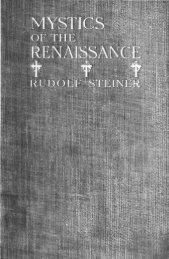The Supreme Doctrine - neo-alchemist
The Supreme Doctrine - neo-alchemist
The Supreme Doctrine - neo-alchemist
You also want an ePaper? Increase the reach of your titles
YUMPU automatically turns print PDFs into web optimized ePapers that Google loves.
Chapter Fifteen<br />
SENSATION AND SENTIMENT<br />
A<br />
T each given moment of emotion there exists a relation, as we have<br />
said, between the images which pass across our mind and our subjacent<br />
emotivity. This relation is complex; it is interesting to study<br />
because it comprises certain very subtle traps which prevent us from paying<br />
attention to our emotivity.<br />
It is important first of all to recall the essential distinction which exists<br />
between the imaginative film founded on the real present and the imaginative<br />
film invented in the mind. When I observe any spectacle in the outer world I<br />
observe it by means of an imaginative film which partially reproduces the<br />
spectacle outside, a film founded on the outer forms that my attention has<br />
seized. When I day-dream, in idleness or in the course of any activity, I<br />
perceive an imaginative film invented in my mind. Emotivity is connected in<br />
very different ways to these two kinds of films. We will study these two<br />
cases, using the following terms: the film founded on the outer world we will<br />
call the 'real imaginative film' (since it is founded on phenomena which, if<br />
they lack absolute reality, have, nevertheless a relative reality); the invented<br />
film we will call the 'imaginary film'.<br />
When it is a question of a real imaginative film the relation which<br />
exists between this film and emotivity is simple enough: the emotivity varies<br />
(quantitative variations of contraction-decontraction) according to the<br />
character, affirming or negating, of the images of the film: the images<br />
associated with a menace to my existence determine the emotive contraction,<br />
those associated with the continuation of my existence determine the<br />
diminution of this contraction, that is a relative relaxation. This reaction of<br />
the emotivity to the images of the real film constitutes a one-way relation: the<br />
form of the imaginative phenomena determines the form of the emotive<br />
phenomena. From the point of view of form the outside world is active and<br />
my inner world is passive. Nothing is motionless; the exterior phenomena<br />
change unceasingly, and the reacting emotivity varies unceasingly. <strong>The</strong>re is<br />
138




